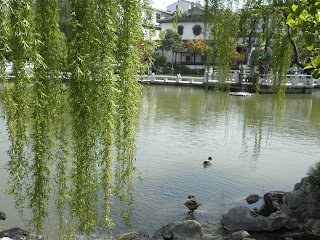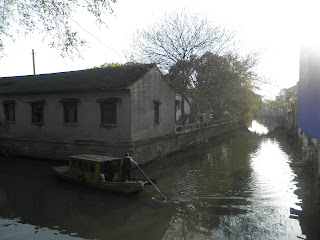Suzhou is a conundrum. It's what you're offered when a city gets trapped in the black hole straddling the past and present. It's a teenager facing for the first time the inevitability of hair in weird places. It's a half-eaten cake on a half-broken plate teetering on the edge of the dining table at twilight. You can say it's a second-rate, trying-hard copycat of its ultramodern neighbor Shanghai, but that would just be too unkind.
This is China's garden city - all 69 of which are designated National Heritage Sites, and eight as UNESCO Heritage Sites. This is also the Venice of the East, with its canals and prominent old city moat and the many boats plying its waters. This is the sister city of Kiev and Antananarivo, Rotorua and Riga, which is to say, a confusing juxtaposition of stone bridges and glass-and-concrete offices.
At the train station, tour group operators abound like vultures hovering above a field of carcass. But they are not scammers. They would most likely be, if they were in the Philippines. But again, they are not. They happen to be legitimate local operators, and the problem they pose isn't so much about dependability as it is about quality.
The train station facade of this relatively minor Chinese city can put any Philippine airport's to shame.
Signing up for a tour means having all your transportation problems solved. So are your entrance fees to destinations of your choice - which means you have to choose carefully, which means doing your research. Our first stop was Ding Yuan - Calm Garden - which, our guide claimed, is the largest of Suzhou's so-called classical gardens; that title belongs to the Humble Administrator's Garden, according to online sources. Also, this isn't one of the eight UNESCO gardens, and that was a total blow to the heart. Still, this is a place of overflowing beauty.
From another perspective, it's justifiable to claim that Suzhou's actually built out of its gardens, this almost insane addiction over rock sculptures and fountains, moats and canals, ponds and lagoons, temples and pagodas and endless stretches of corridors and foliage-laden walkways. Take this outcrop of bamboo, for example:
Or how about this oriental imitation of a gondola, which we took alongside two elderly visitors smoking what could only be the most noxious-smelling cigarettes:
Next stop was a boat ride around the old city moat, and it was here that we fully appreciated the complexities of joining a local tour group. The guide was very much alive and stuffed with everything we tourists needed to know about the boat ride and the sites and pieces of culture along the route. In Mandarin, of course.
Amazing, though - and quite commendable, too - that the Chinese know their history. Everyone was quite game in answering the guide's questions concerning this site or that dead person, highlighting what can only be their educational system's emphasis on history.
Our third major attraction was the Hanshan ("Cold Mountain") Temple, a Buddhist haunt that's probably billowing with joss stick and candle smoke on busy days. The Tang poet Zhang Ji wrote about hearing the temple bells in his poem "A Night Mooring by Maple Bridge."
We also went to the local silk and jade museums, which were totally not worth going. The silk museum is supposedly a worthier place, but actually, it's just plain rich-tourist bait. Both museums, really. It was fun looking at the demonstration of the properties of silk fabric and the preserved models of silkworms in various life stages while they lasted. Below: Fancy bedroom stuff for the beneficiaries of China's recent rise in the economic sphere.
In my opinion, however, the best part of our day came after the tour. With our train still three hours away and the sun far from setting, we asked to be dropped off at the northern end of Pingjiang ("Peaceful River") Road. Once the main artery coursing through the old city, this charming street that runs parallel its own canal is now representative of a bygone era, bustling with pedestrians, cafes and restaurants, bookshops and clothing stores and vendors selling a myriad of delights.
Restaurants get away with the old-school/new-school game.
Bookstores sell interesting notebooks while making a statement.
This is where med students would study in Pingjiang Road.
This was when we realized that the gondola-like rides only ply the smaller canals - this road's, for example. They don't come cheap, though.
Another highlight of walking down this strip was ogling at the prenuptial photoshoots. And, ehem, photographing the engaged couples. Or making epal, in Filipino conyo parlance.
Restaurants get away with the old-school/new-school game.
Bookstores sell interesting notebooks while making a statement.
This is where med students would study in Pingjiang Road.
This was when we realized that the gondola-like rides only ply the smaller canals - this road's, for example. They don't come cheap, though.
Another highlight of walking down this strip was ogling at the prenuptial photoshoots. And, ehem, photographing the engaged couples. Or making epal, in Filipino conyo parlance.
And so, farewell, fine water town. Know that once, two Filipino medical students trampled upon your fresh earth for a day and became superstars to your tour guides and a bunch of local tourists - the pair of Filipinos "for whom we have to slow down our Mandarin a bit," as tour guide with the ginormous fur coat placed it.
PREVIOUS: China 2013 Part V: The Most Epic Bicycle Ride in the World
NEXT: China 2013 Part VII: In Shanghai, A Piece of Paris
PREVIOUS: China 2013 Part V: The Most Epic Bicycle Ride in the World
NEXT: China 2013 Part VII: In Shanghai, A Piece of Paris




























No comments:
Post a Comment